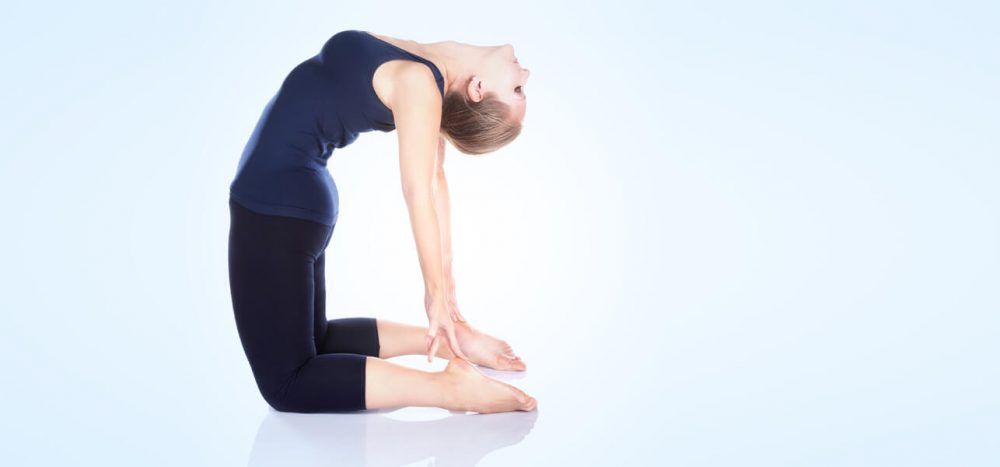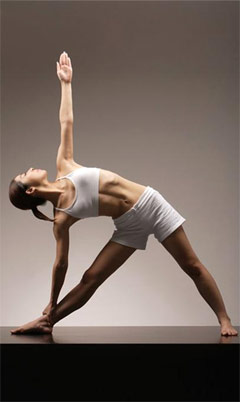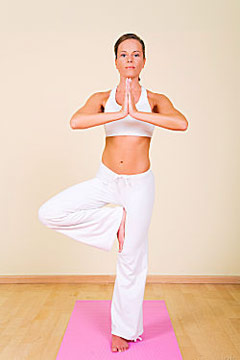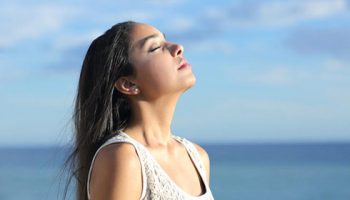Women Fitness has modified some yoga asanas to provide you with a gentle progression, and are especially useful for those new to yoga. If you find any of these poses too difficult for now, do not worry, you can simply compose a sequence. There are many standing poses can also be practiced more easily with your back against a wall. If you stand a half-foot away from the wall, you can then use it as a support for your back by leaning against it while in the pose.

Standing poses have been described here as rhythmical sequences. Movement that flows with the breath is relaxing, effective and more “yogic” than a stretch in which you try and conform to a pre-set notion of how you should look in a posture. Before you feel comfortable holding “asanas”, the word for classical yoga poses which implies steadiness of body, breath and mind, you can practice at least some of these using movement and rhythm. When you hold a pose, however, the dynamic is created inside your body with breathing. This is what makes yoga poses enjoyable.
Whenever you feel tension, come out of it and relax.
Tadasana (Mountain Pose)
- Stand tall with feet together, shoulders relaxed, weight evenly distributed through your soles, arms at sides.
- Take a deep breath and raise your hands overhead, palms facing each other with arms straight. Reach up toward the sky with your fingertips.
Dynamic Archer Pose
- Stand in Tadasana. This is the starting pose for standing postures in yoga.
- Jump or walk your feet about 1m/3ft apart. Turn your right foot out, your left foot in. inhale, raising your arms open to shoulder level without tensing them. Exhale bending your right knee and turning your head right, extending both arms as much as you can. Inhale, straighten your legs, centre your head and turn the left foot out, right foot in. exhale, stretching to the left. Continue alternating sides in an easy rhythm.
“Easy” Triangle Pose (Trikonasana)
 Find an easy rhythm, stretching only as far as you can go without disturbing your relaxed breathing. This sequence combines a stretch (the Archer Pose) and an open twist in the Triangle Pose.
Find an easy rhythm, stretching only as far as you can go without disturbing your relaxed breathing. This sequence combines a stretch (the Archer Pose) and an open twist in the Triangle Pose.
- Begin in the Archer Pose. With your feet still apart and your arms extended, tilt your trunk to the right. Breathe naturally, letting your right hand slide down your right leg to the point where you feel you cannot go any further down without bending forward. Lift the inner arch of your right foot.
- Keeping your weight on the left leg, inhale and stretch from your left heel all the way to the fingertips of your left hand. Look at your left hand and stretch more as you exhale. Come back to centre and repeat on the left side.
“Easy” Forward Bend
- It is pleasant to let gravity stretch your spine while your shoulders, neck and head can relax completely in this forward bend, which also stretches the back of your legs.
- When you have stretched both sides a couple of times, come back to the centre and lower your arms to flop into a gentle forward bend. Relax your neck. You may like to swing your head and shoulders gently from side to side, to ease your lower back. Bend your knees as you breathe in to come up from this pose.
“Easy” Tree Pose (Vrikshasana)
 Start with a low chair or stool for this pose and graduate to a higher one as you become more confident and flexible. (You may prefer to have your back against a wall to do both this pose, if your balance is unsteady.)
Start with a low chair or stool for this pose and graduate to a higher one as you become more confident and flexible. (You may prefer to have your back against a wall to do both this pose, if your balance is unsteady.)
- Stand in Tadasana, facing the chair. Place one foot on the chair and bring your hands into Namaste (the prayer position). Use deep breathing to stretch and align your spine and centre your energies. Hold the pose with your body, breath and mind remaining steady.
- When you feel ready, bring your knee up towards your chest, with both hands clasped below your knee. Keep steady and balanced, with your spine in line. As you breathe out squeeze your bent leg towards your body and release as you breathe in. Breathing deeply, hold the position for a moment. Release, regain your balance and steadiness, then bend the other knee and repeat.
Note: Pay close attention to the name and instruction of the yogasana.
Related Links
Disclaimer
The Content is not intended to be a substitute for professional medical advice, diagnosis, or treatment. Always seek the advice of your physician or other qualified health provider with any questions you may have regarding a medical condition.
